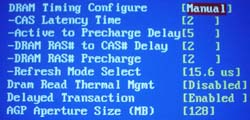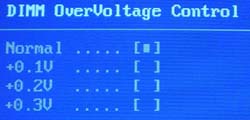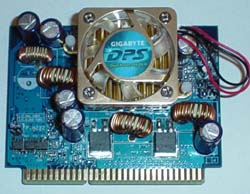Intel's E7205: Granite Bay Hits the Streets
by Evan Lieb on November 18, 2002 9:56 AM EST- Posted in
- Motherboards
Gigabyte 8INXP: BIOS and Overclocking
Not surprisingly, we see that Gigabyte uses the Award BIOS.
The PC Health section includes a good deal of information, although pretty average by today's standards.
In PC Health you'll find only one temperature reading, CPU temperature. This reading ended up fluctuating between 45-47C, which is unusual because we're used to seeing CPU temperatures between 38 and 43C with our particular 2.26B Pentium 4 CPU. Perhaps this is simply an early BIOS issue. Other PC Health readings include fan speeds for the CPU, power, and system fan headers. Vcore and PSU readings (all rails) are also included, and are normal for the most part. Finally, we see that there are four "Warnings" options in PC Health. These include CPU warning temperature, CPU fan failure warning, power fan failure warning, and system fan failure warning. Fan failure warnings are a nice little feature to have, since fan failure is not that uncommon.
Gigabyte continues their recent trend of hiding the Advanced Chipset Features section in the 8INXP BIOS. You have to press and hold CTRL while hitting the F1 key to bring up the Advanced Chipset Features section in the BIOS. Some readers have emailed us asking why Gigabyte hides this feature in their BIOS, and even we were stumped for a while before we got an answer. Gigabyte's explanation is quite simple; they don't want users messing with DRAM timings, as it can cause system instability. We think this is fair, especially since Gigabyte does mention the CTRL + F1 feature in their manual.

As far as the features in the Advanced Chipset Features section are concerned, there isn't anything we haven't seen before. You're allowed to adjust CAS Latency, Precharge to Active, Active to Precharge, Active to CMD, and a handful of other options that don't boost performance whatsoever. We weren't astonished to see the absence of Bank Interleave or Command Rate options, since we can't remember the last time we encountered a BIOS for an Intel chipset based motherboard that had these options. You'll see Command Rate and Bank Interleave options in SiS 648 motherboards more often than not. All in all, DRAM tweaking is fair, and the Top Performance feature (located outside of Advanced Chipset Features) is a nice plus.
As should be expected with all Granite Bay motherboards from this point on, Gigabyte's 8INXP contained absolutely no divider adjustments besides 1:1. There were no onboard jumpers or switches that could have changed this fact either. This isn't surprising, as all you really need is a 533MHz FSB processor and two modules that can ran at 266MHz or better to squeeze out the best performance from your system. This assumes you don't overclock since, as we mentioned before, the only way you can increase your memory speed beyond 266MHz with a Granite Bay motherboard is by increasing the FSB.
Voltage adjustments are fairly plentiful in the 8INXP BIOS. VDIMM is adjustable as high as 2.8V in 0.1V increments, which should be adequate for all users, including most memory overclockers. VAGP is also quite adjustable; in 0.1V increments you can adjust VAGP all the way up to 1.8V. Video card overclockers will have no gripes with this type of voltage flexibility.

Vcore options are pretty good for this particular motherboard. Since most P4 overclockers don't really need to raise Vcore to get a large overclock, having the ability to raise Vcore anywhere past 1.6V or so really isn't necessary (using a 1.5V Northwood CPU of course). This BIOS allows for "only" 1.725V in 0.025V increments. Vcore reads steady at 1.5V according to PC Health, so hitting an actual 1.725V should be a reality. So, while not spectacular, the Vcore ceiling for this BIOS is acceptable.

Additionally, we see that the 8INXP BIOS includes the much welcomed AGP/PCI lock feature. We've become accustomed to seeing this feature on almost all 845-based as well as nForce-based motherboards in the last year or so, and we welcome the day SiS and VIA motherboards start fully implementing AGP/PCI lock functions. This AGP/PCI lock is also adjustable as high as 48MHz/97MHz instead of the stock 66MHz/33MHz if you are interested in even more overclocking adventures. Be forewarned though, it generally isn't advisable to go higher than 70MHz/37MHz, as your AGP and/or PCI devices may fail.

We ran some overclocking tests on the Gigabyte 8INXP, which ended up performing very well in our benchmarks, as you will see shortly. The following table lists the components we used for overclocking the FSB using the 8INXP motherboard:
|
Front Side Bus Overclocking Testbed |
|
|
Processor:
|
Pentium
4 2.26GHz
|
|
CPU
Vcore:
|
1.5V
(actual)
|
|
Cooling:
|
Intel
Retail HSF & Thermal Pad
|
|
Power
Supply:
|
Enermax
300W
|
With this setup we were easily able to hit 163MHz FSB, or about 2.78GHz core clock. Looking at both the Gigabyte 8INXP and ASUS P4G8X, it becomes clear that Granite Bay boards will probably end up overclocking no worse than 845PE motherboards. However, as you'll see shortly, overclocking benchmarks are another story altogether.
We were skeptical about Gigabyte's DPS (Dual Power System) system at first, even if it did turn the 8INXP into a 6-phase motherboard. After numerous benchmarks and overclocking tests, we can safely conclude that DPS does absolutely nothing for overclocking stability or otherwise. Not surprisingly, performance was the same as was general stability. However, we would be interested in knowing if DPS does anything for the longevity of the onboard components as well as the motherboard itself.

As with the ASUS P4G8X, the Gigabyte 8INXP does not have any other dividers besides 1:1. Therefore, we weren't able to run any memory overclocking tests that would have been as worthwhile as they turned out to be in our October 7th 845PE shootout . We early await SiS 655 motherboards for this reason.










2 Comments
View All Comments
hrumsey - Friday, January 7, 2005 - link
Regarding previous comment:And I told this thing to show e-mail address. hrumsey@charter.net if anyone has questions.
It also removed paragraph indents that would make the above post a bit more readable- apologies.
And a clarification: The ZCR card could be seen to be flashed only because a jumper change is needed to put them in flash mode. In normal mode, the Thunder K8S Pro S2882 BIOS was squashing the Adaptec 2010S / 2015S BIOS.
Damn, I hope Google indexes that comment well.
Speaking of which, for you-know-who:
Tyan Thunder K8S Pro Adaptec 2010S 2015S ZCR RAID BIOS problem incompatibility bug hang failure download flash PCI-X
Tyan 2882 K8S Pro Thunder ZCR Adaptec 2015S 2010S RAID bug hang failure problem incompatibility PCI-X flash BIOS download
Thunder Tyan 2882 K8S Pro ZCR Adaptec RAID 2010S 2015S BIOS incompatibility problem failure hang PCI-X BIOS bug flash download
wildly incompetent screen-reading technical support monkeys
beta-testing on customers
See previous comment
hrumsey - Friday, January 7, 2005 - link
Anandtech's evaluation covers how good Tyan's tech support is in the absence of any real problem for them to deal with. I would suggest that this is not an adequate criterion.Our experiences were different.
The issue of product quality is relevant here, since it makes the quality of technical support more important if the product is poor. My company tried Tyan boards several years ago, and gave up when along with 4 DOAs, 3 quick in-service failures gave a defective rate of almost 50%. I mistakenly thought almost 10 years would be enough for the company to straighten out.
We ordered 3 Thunder Pro S2882s for a client taking a website inhouse who wanted a 64-bit option- this was before Intel's 64-bit Xeons showed up.
All of the following happened under time pressure, which isn't unusual, and why better support than Tyan's is necessary:
One of the three boards was DOA; wouldn't flash any of three Adaptec 2010S ZCR cards; the other two would. Tyan's tech support essentially kept assuming we were doing something wrong and, and at one point asked if we had the current BIOS on the ZCR cards. They must not have any sort of decent database, since the problem had to be explained anew every call. After they admitted the board was bad, they failed to warn us of their shipping deadline for replacing the board (which they will do, and with an E. Coast vendor and them in CA was necessary).
All the boards failed to see the ZCR cards. First tech said that couldn't be happening, second knew about the problem and said the "E" BIOS fixed it. It didn't. We delivered servers with drives unmirrored.
Site setup was busy for a while. When I finally had a chance to work on ZCR problem, Tyan could find no record of the problem (none of the emails we exchanged except ones I sent had case #s in the header). I explained everything again, and once again had to assure them again that we'd gotten the obvious stuff right. First tech said he didn't know how it could be happening, and thought I was missing something. Got email next day from supervisor acknowledging there was a problem and saying (again) they had a new BIOS out that would fix the problem. Downloaded, sent tech onsite to install. Didn't work, same result- ZCR card option grayed out in BIOS, system hangs. When I had a chance to go down and work on it personally, once again, no record of case. I went through everything from scratch once more, assuring them that yes, we'd read the FAQs and yes, the system was plugged in, and yes, we had tried every possible combination of their two blasted relevant jumpers, and that in fact there were about eight other germane parameters we had tried which none of them had thought of- and all of this while wasting valuable onsite time. When I finally convinced them that 1) we were competent and 2) it wasn't working, I was told I'd get a call back "shortly" from the responsible engineer. Three hours later, in a darkened factory, at 5:14:55 just as I was leaving, I got a call back from the engineer who actually knew what was going on. He finally admitted we had everything right. He had no solution, but agreed with my suggestion for testing and said he'd check- he lacked authority(!)- to see if management would authorize the replacement board I'd been asking for. And they did, but there shouldn't have been any question.
Next trip down I replaced the board in one server, picking the server in whichhe Gigabit Ethernet ports had failed- and it still didn't #$%^& work. Tyan said it had been working the day before for them with a 2010S ZCR card, and until today, I didn't know whether they were lying or not. I cussed some and ordered $1200 worth of controllers to replace what Tyan couldn't get right 5 months after the product's release.
Today I checked and saw that they have a new BIOS for the board available that "Fixes PCI ZCR card hangs system during POST". It's the third BIOS for which they've made that claim, and you know, it really doesn't matter whether they're right this time or not. And if they're not, it doesn't matter whether they're just mistaken or actually lying- theend result is the same.
We saw five of their high-end server boards. One DOA, one in-service failure, all five with a major design flaw. Eight years is enough time to take care of company-wide failures. Any company that will release a $500 server board with a 40% failure rate, and without first ensuring that everything on it actually works, and who then can't tell for five months whether or not they've fixed the resulting problems, and whose tech support is staffed with folks who can't deal those problems- well, that's a company whose products you want to steer very clear of.